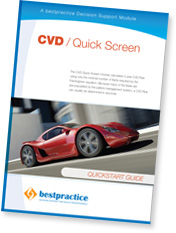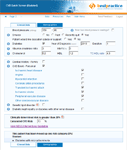Cardiovascular Disease Quick Screen module

Introduction
The CVD Quickscreen module calculates five year Cardiovascular Risk using only the minimal number of fields required by the Framingham equation. Because many of these fields are pre-populated by the patient management system record, a Cardiovascular Risk can usually be determined in seconds.
Background
Cardiovascular disease (CVD) is the leading cause of hospital admissions and mortality in New Zealand. It is recommended that decisions on prevention and treatment of cardiovascular disease are based on the likelihood of a person having a cardiovascular event over five years. These cardiovascular events include heart attack, angina, stroke, peripheral vascular disease and heart failure.
This means treatment in New Zealand is no longer focussed on individual risk factors but on a person’s absolute cardiovascular risk. The CVD risk can be estimated using information on age, gender, blood pressure, total and HDL cholesterol, smoking, and whether or not a person has diabetes. From the mid 1990s paper-based CVD risk charts have been available in New Zealand to estimate peoples’ risk of having a cardiovascular event over five years. However these may have been under-used so a programme to increase risk assessment and management using internet-based clinical decision support systems has been developed.
The BPAC Inc web-based Decision Support system calculates and displays a person’s absolute CVD risk then automatically saves it in a standard way to the patient’s medical record. This makes it superior to paper-based charts that can be interpreted in different ways, provide absolute cut-offs and require coding to a patients’ notes.
How it works
BPAC’s CVD Quickscreen uses data that is already in a patient’s medical record so the cardiovascular risk can usually be determined in seconds. It then automatically saves this in a standard way directly to the patient’s medical record.
At any time, users can hover the cursor over the info icon to get more information relevant to the adjacent field.
Links
- New Zealand Cardiovascular Guidelines Handbook 2009 Edition available from the New Zealand Guidelines Group
- Cardiovascular Disease from Best Practice Journal, October 2008
- What’s new in the 2009 Cardiovascular Guidelines Handbook from Best Practice Journal, June 2009
Featured module

The Depression in Young People module addresses the identification of common mental disorders and the management of depression in primary care.
For more modules see the full list of standard modules.
Latest News
ACC18 Enhancements - Effective 27 November
Calendar, Printing and ACC Identifiers
In response to feedback, the online ACC18 continues to launch enhancements; the following will be available from 27 November.
Fitness for Work Tab - Calendar: Moving the mouse over the calendar for longer periods has been made easier.
Declaration Tab - ACC Identification: There will be a reduction in the number of identifiers from five to four; no direct impact on the Provider.
If you are one of the over 2000 Practitioners who regularly use the online ACC18; thank you. If you are not then now would be a good time to begin, noting that additional return to work assistance for patients is offered solely through this online form. Self service for setting up and using the online ACC18 is available at www.acc.co.nz (use keyword eACC18 Self Service). However, feel free to contact ACC at 0800 222 994 or ebusinessinfo@acc.co.nz for more personalised support.
Most Popular Modules
The five most popular modules in June were:
- Patient Prompt
- The Common Form
- e-Referral System
- ACC 18 Form
- CVD Quick Screen
To see more, go to the Statistics page.
Getting Started guide
The Getting Started guide is a good place to start if you are new to bestpractice Decision Support. The articles in the guide provide a quick and focussed introduction to the areas of most interest to new users of bestpractice.
About BPAC Inc
bestpractice Decision Support is produced by BPAC Inc. To find out more about us, click here.









